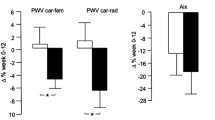Summary
The renin-angiotensin system relevantly contributes to the maintenance of systemic vascular tone and there is experimental evidence that large amounts of angiotensin-converting enzyme (ACE) are present in peripheral vascular tissues, including resistance vessels. To determine and quantify peripheral vascular conversion of angiotensin-I (ANG-I) to angiotensin-II (ANG-II) across the human leg, the response of regional blood flow to local regional intra-arterial infusion of ANG-I and changes in associated ANG-I1 balance were evaluated during ANG-I infusion and following additional ACE inhibition. Ten sodium-loaded healthy men were enrolled in the study. Following cannulation of both femoral arteries and the right femoral vein, leg blood flow was determined (indocyanine-green dye-dilution method) at baseline conditions and during constant intra-arterial infusion of haemodynamically ineffective doses of ANG-I as well as following concomitant intra-arterial administration of low doses of the non-sulfhydril ACE inhibitor cilazapril. From the transfemoral arterio-venous differences in ANG-II plasma concentrations and the corresponding regional blood (plasma) flow, the ANG-II balance across the leg was calculated. Systemic blood pressure did not change throughout the trial, indicating that no major systemic effects were present during ANG-I infusion or concomitant ACE inhibition. Moreover, arterial ANG-II plasma concentrations were not significantly changed by ANG-I infusion. Leg blood flow decreased to below baseline values following ANG-I infusion, increasing again then in a dose-dependent manner during concomitant cilazapril administration. The calculated baseline ANG-II balance across the leg revealed a net extraction in 6 out of 10 subjects and a net ANG-II formation in 4. Following ANG-I, a shift towards net ANG-II formation or decrease in extraction was seen in 8 subjects, while 2 had no change in ANG-II balance.
During concomitant ACE inhibition, ANG-II balance was again shifted towards net extraction or reduced formation. Our results confirm that, in man, considerable regional arterio-venous differences in ANG-II plasma concentrations are present, resulting in either net transfemoral extraction or net formation of the peptide. It is suggested that systemic vascular conversion of circulating ANG-I might contribute to the maintenance of peripheral vasuclar tone in man.
Similar content being viewed by others
References
Aiken JW, Vane JR (1972) Inhibition of converting enzyme of the renin-agiontensin system in kidneys and hindlegs of dogs. Circ Res 30:263–273
Bünning P, Budek W, Escher R, Schönherr E (1986) Characteristics of angiontensin converting enzyme and its role in the metabolism of angiotensin I by endothelium. Journal of Cardiovasc Pharmacol 8 (Suppl 10):52–57
Campbell DJ (1985) The site of angiotensin production. J Hypertension 3:199–207
Chai SY, Allen AM, Adam WR, Mendelsohn FAO (1986) Local actions of ANG-II: Quantitative in vitro autoradiographic localization of ANG-II receptor binding and angiotensin converting enzyme in target tissues. Journal of Cardiovasc Pharmacol 8 (Suppl 10):35–39
Creager MA, Faxon DP, Rockwell SM; Melby JC, Gavras H; Coffman JD (1984) Effect of renin-angiotensin system on limb circulation in normal subjects. Evans Memorial Dep of Clin Res and Dep of Med, Boston Univ Medic Cen Am J Physiol 246:239–244
Dzau VJ; Ingelfinger JR, Pratt RE (1986) Regulation of tissue renin and angiotensin gene expressions. Journal of Cardiovasc Pharmacol 8 (Suppl 10):11–16
Fei DTW, Scogginst BA, Tregear GW, Coghlan JP (1981) Angiontensin I, II and III in sheep: a model of angiotensin production and metabolism. Hypertension 3:730–737
Jorfeldt L, Wahren J (1971) Leg blood flow during exercise in man. Department of Clin Physiol, Karolinska Institutet, Serafimerlasarettet, Stockholm, Sweden. Clin Sci 41:459–473
Kreye VAW, Gross F (1971) Conversion of ANG-I to ANG-II in peripheral vascular beds of the rat. Am J Physiol 220:1294–1296
Lochs H, Williams PE, Morse EL, Abumrad NN, Adibi SA (1988) Metabolism of dipeptides and their constituent amino acids by liver, gut, kidney, and muscle. Amer J Physiol 254:E588-E594
Miyauchi Y, Nishimura K, Ueda E, Kokubu T (1981) Angiotensin-converting enzyme activity in the vascular tissue from rabbits. Biomed Res 2:364–366
Miyazaki M, Okamura T, Okunishi H, Toda N (1986) Vascular angiotensin converting enzyme in the development of renal hypertension. J Cardiovasc Pharmacol 8 (Suppl 10):58–61
Mizuno K, Nakamaru M, Higashimoni K, Inagami T (1988) Local generation and release of angiotensin II in peripheral vascular tissue. Hypertension 11:223–229
Nakamaru M, Jackson EK, Inagami T (1986) Role of vascular ANG-II released by ß-adrenergic stimulation in rats. Journal of Cardiovasc Pharmacol 8 (Suppl 10):1–5
Natoff II, Nixon JS, Francis RJ, Klevans LR, Brewster M, Badd J, Patel AT, Wenger J, Worth E (1985) Biological properties of the angiotensin converting enzyme inhibitor cilazapril. J Cardiovasc Pharmacol 7:569–580
Oparil S, Koerner T, O'Donoghue JK (1979) Mechanism of angiotensin I converting enzyme inhibition by SQ 208801 in vivo: further evidence for extrapulmonary conversion. Hypertension 1:13–22
Pasden V, Müller MJ, Sites HJ (1981) Indocyanine green liver blood flow measurements in the pig (Abstract) J Chem clin Biochem 19:797A
Swales JD (1979) Arterial wall or plasma renin in hypertension? Clin Sci 56:292–298
Vane JR (1972) Sites of conversion of angiotensin I. Genset J, Koiw E (eds) Hypertension Springer-Verlag, New York, pp 523–532
Webb DJ, Collier JG (1986) Vascular angiotensin conversion in humans. J Cardiovasc Pharmacol 8 (Suppl 10):40–44
Author information
Authors and Affiliations
Additional information
Send offprint requests to S. Gasic at the above address
Rights and permissions
About this article
Cite this article
Gasic, S., Heinz, G. & Kleinbloesem, C. Quantitative evidence of peripheral conversion of angiotensin within the human leg: effects of local angiotensin-I administration and angiotensin-converting enzyme inhibition on regional blood flow and angiotensin-II balance across the leg. Naunyn-Schmiedeberg's Arch Pharmacol 342, 436–440 (1990). https://doi.org/10.1007/BF00169461
Received:
Accepted:
Issue Date:
DOI: https://doi.org/10.1007/BF00169461




